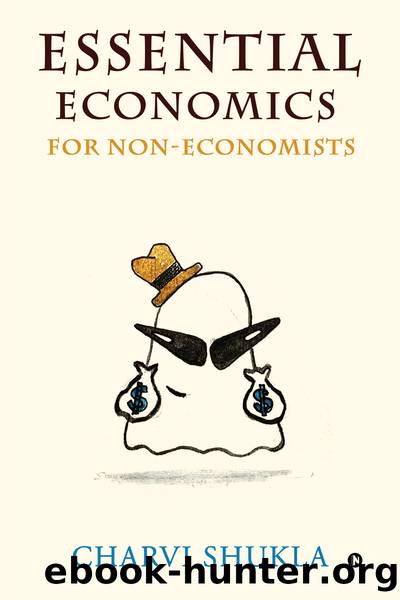Essential Economics For Non-economists by Charvi Shukla

Author:Charvi Shukla
Language: eng
Format: epub
Publisher: Notion Press
Published: 2021-03-02T00:00:00+00:00
Income and Substitution Effect
So you work in Walmart and Christmas is close, so your manager gives you a pay raise. Now that you have more money in your pocket, your purchasing power has increased. Since you have more money, you would obviously buy yourself more presents. Your purchasing power has increased. Conversely, if you experience a salary cut, you will have less money and would purchase a smaller quantity of goods.
This effect of changes in consumption because of changes in income is known as the income effect. Income effect can be direct or indirect. When a consumer chooses to make changes to the way he or she spends because of a change in income, the income effect is said to be direct. However, when there are changes in patterns of spending because of changes in other factors, the change is said to be indirect. Imagine that the market price of avocados has risen. Earlier you wouldâve bought 5 avocados while grocery shopping, but now you can only purchase 3 because your purchasing power has fallen. The income effect can be explained using the concept of Marginal Propensity to Consume. It is a concept based on the balance between the spending and saving habits of consumers. The marginal propensity to consume is included in a larger theory of macroeconomics known as Keynesian economics.
In the previous chapter, we have already seen what substitute goods are (two goods that can easily replace each other). When you experience a pay raise, you substitute low price products for more expensive and better quality products. For instance, following a pay raise, you decide to replace your Android mobile phone for a new iPhone 12. This leads to a decrease in the consumption of Android phones and an increase in the consumption of iPhones. The inverse is true when incomes decrease. When you are low on budget, you would prefer to purchase cheaper goods instead of more expensive goods. Here, it is important to note that we are assuming that the good is a normal good and its demand increases when the price of the good decreases.
While the substitution effect changes consumption patterns in favor of the more affordable alternative, even a modest reduction in price may make a more expensive product more attractive to consumers. If airplane ticket prices are high and train prices are low, consumers would naturally prefer to travel using a train if budget is a concern. However, if the airplane ticket prices fell a little bit, people would be more attracted to travel using an airplane.
Interestingly, the substitution effect is not limited to consumption. It also comes into play when firms outsource parts of their operations. Using cheap labor in poorer countries can have a benefit for the companies because they are substituting cheap labor for expensive labor at home. However, the benefit for those laborers would be negative because they would be earning far less than what laborers in other developed economies would.
In order to graphically analyze income and substitution effect, we draw budget constraints and indifference curves on the same axis.
Download
This site does not store any files on its server. We only index and link to content provided by other sites. Please contact the content providers to delete copyright contents if any and email us, we'll remove relevant links or contents immediately.
| CPA Test | GMAT Test |
| Statistics |
Weapons of Math Destruction by Cathy O'Neil(6148)
Cracking the GRE Premium Edition with 6 Practice Tests, 2015 (Graduate School Test Preparation) by Princeton Review(4227)
What It Really Takes to Get Into Ivy League and Other Highly Selective Colleges by Hughes Chuck(3697)
Fooled by Randomness: The Hidden Role of Chance in Life and in the Markets by Nassim Nicholas Taleb(3046)
The Tyranny of Metrics by Jerry Z. Muller(3003)
The Marketing Plan Handbook: Develop Big-Picture Marketing Plans for Pennies on the Dollar by Robert W. Bly(2977)
Ultralearning by Scott Young(2890)
The Official Guide for GMAT Review 2015 with Online Question Bank and Exclusive Video by Graduate Management Admission Council (GMAC)(2759)
50 Economics Classics by Tom Butler-Bowdon(2524)
Bull by the Horns: Fighting to Save Main Street From Wall Street and Wall Street From Itself by Sheila Bair(2127)
The Visual MBA by Jason Barron(2099)
The Inevitable by Kevin Kelly(1929)
Data Science for Business by Foster Provost & Tom Fawcett(1907)
Cracking the LSAT, 2012 Edition by Princeton Review(1886)
Out of the Crisis by Deming W. Edwards(1845)
GMAT Official Guide 2018 Verbal Review by GMAC (Graduate Management Admission Council)(1810)
The Personal MBA: Master the Art of Business by Josh Kaufman(1774)
The Conflict Resolution Phrase Book by Barbara Mitchell & Cornelia Gamlem(1735)
Maths and Stats for Web Analytics and Conversion Optimization by Himanshu Sharma(1657)
